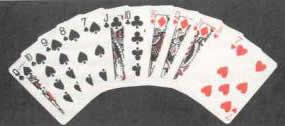A good general poker rules emerges. The discards of the non-dealer should be made towards obtaining an attacking hand; that of the dealer towards obtaining a defensive hand; that is to say a hand in which there is some strength in as many suits as possible.

Subject to these considerations, it is best to discard from as few suits as possible, and, once a player has made up his mind to discard from a suit, he should discard the whole of it, unless it is necessary to retain the suit guarded.
Sequence cards should be retained in preference to non-sequence cards, and of course, cards should be retained in preference to non-sequence cards, and of course, cards that help to make up trios and Quatorze should never be discarded if it is to be avoided.
Playing go the score is very important, particularly in the last deal of a partie. As an example: if a player is well ahead, and sees the opportunity to gain a rubicon, he should discard cautiously and play so as to prevent his opponent from saving the rubicon by scoring 100 points. On the other poker hand, if a player is in danger of being rubiconed, he should be prepared to take some risks, since only a big score will save him.
It must be remembered, however, that if a player is rubiconed his score is added to that of his opponent, so if there is no chance of saving the rubicon he should play to keep his score down. To this end he should declare only equities or those scores that will save pique and repique, and he should aim to divide the cards.
AUCTION PIQUET
This version originated in Oxford, and was developed by some British prisoners of war during the First World War.
The bidding takes place before the discard. It is opened by the non-dealer. He may pass, and if he does and the dealer does also, there is a redeal by the same player. The lowest bid that may be made is one of seven.
It is an undertaking to win, or lose, seven of the 12 possible tricks. There is no penalty for a bid out of turn or for an underbid, because these irregularities merely give information to the opponent.
The most interesting feature of the game is the minus bid. It is an undertaking to lose the stated number of tricks. It ranks neither above nor below a normal (plus) bid. In a minus deal the player scores everything good in his opponent’s hand. A player may double a bid made by his opponent, and the player who has been doubled may redouble or shift to a higher bid.
After bidding, the players discard. The routine is the same as in the parent game except that there is no compulsion for the players to discard at least one card.
The declarations follow, and the players may declare the point, sequences, trios and Quatorze in any order they choose. Sinking is allowed in plus deals but not in minus ones.
The scoring is as follows:
- The value of point, sequences, trios, Quatorze, cars and capot, are the same as in the parent poker game.
- In plus deals pique (30 points ) is obtained on the score of 29 and repique (60 points) on the score of 30. In minus deals both pique and repique are obtained on the score of 21.
- The partie (six deals ) is worth 150 points, and rubicon is under 150 points. In the event of a tie a seventh deal is played and the partie ends if it is tied.
- A player scores 10 points for every trick won in a plus deal (or lost in a minus deal) above (or below) the declared contract.
- If a player fails to make his contract the opponent scores 10 points for every trick by which he is short. Overtricks and undertricks are effected by doubling and redoubling, but scores in hand and play are not.
Although a player scores one point for winning a poker trick he does not score for leading a losing card, nor an additional one point for winning the last trick.
